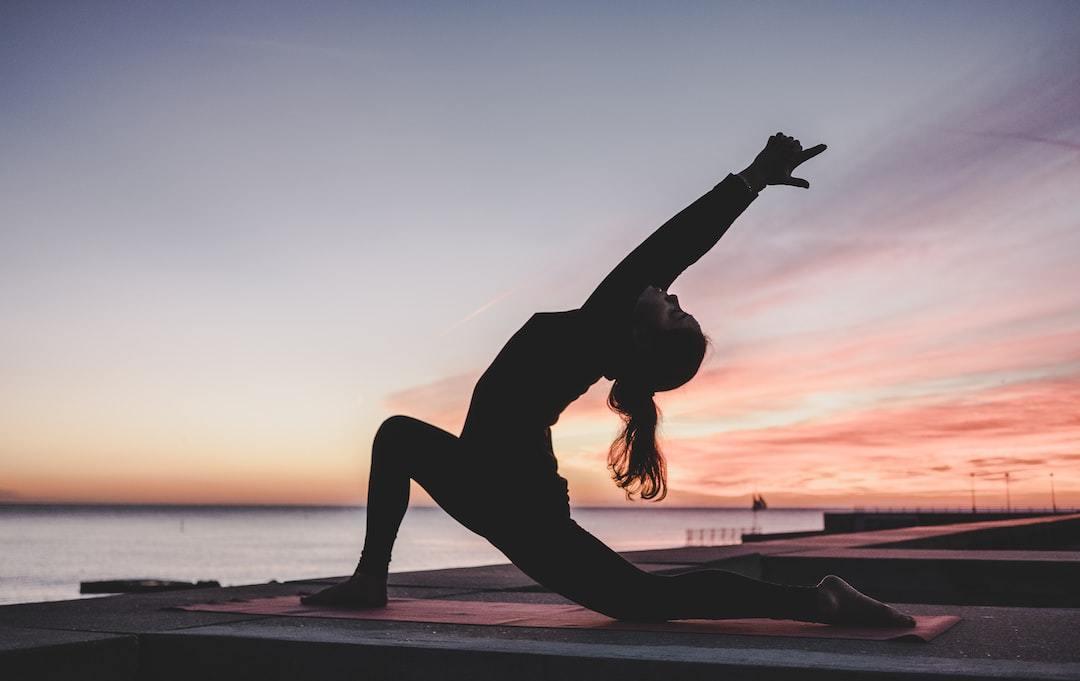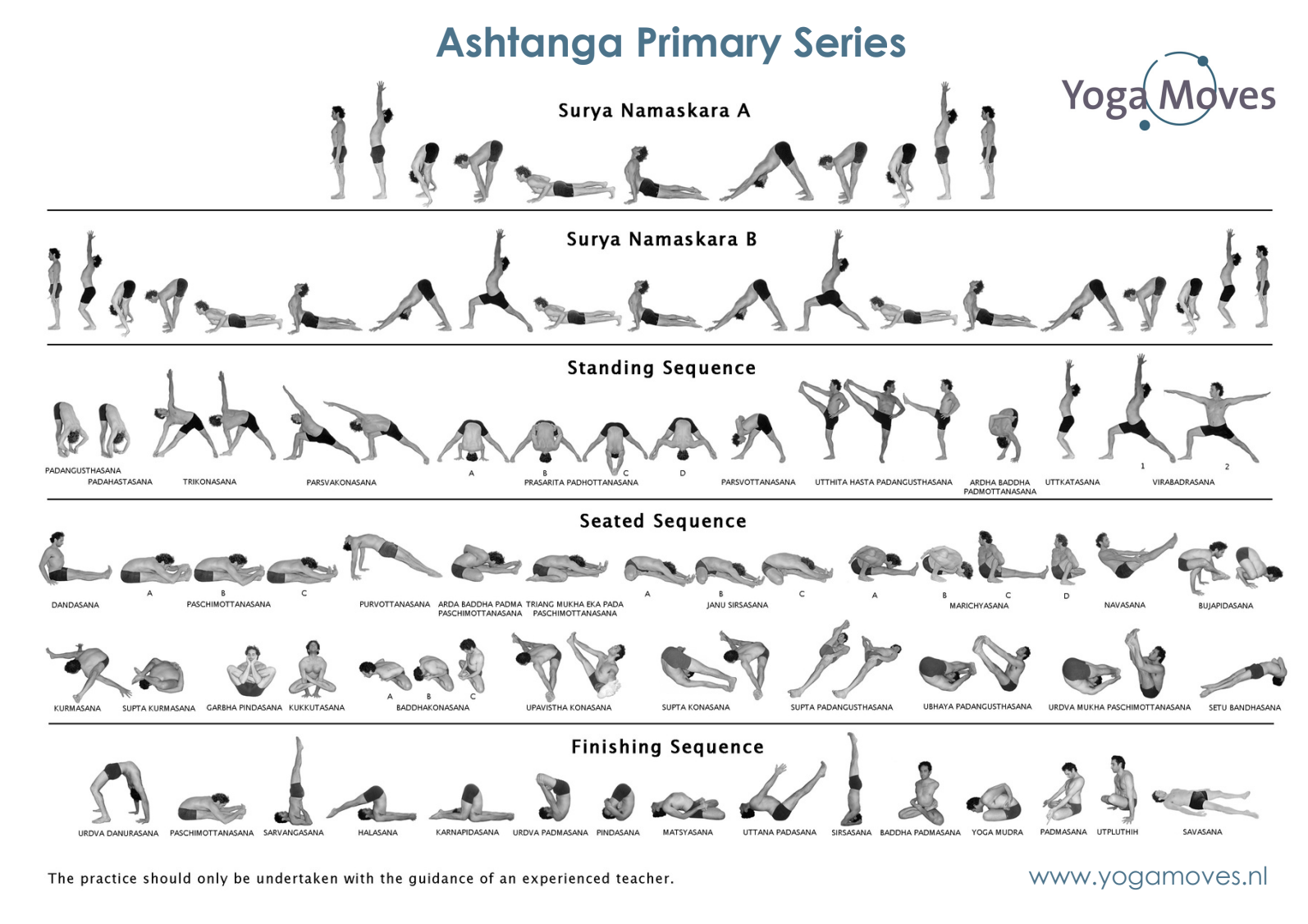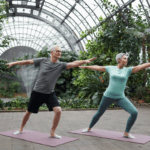Coming Soon: E-book about Kundalini Yoga - Sign up here to be among the first to get it!
Ever been caught in a yoga rut? You’ve mastered your downward dog and perfected your tree pose, but you’re yearning for something more. Ashtanga yoga, with its dynamic flow of poses and deep connection to breathwork, might be just the thing to reinvigorate your practice.
Picturing it yet? Imagine starting each day greeting the sun with a salute, as Ashtanga’s rhythmic sequence fuels both body and mind. Your mat becomes an island of calm amid life’s chaos. But there’s so much more than stretching here; we’re talking about developing mental resilience, fostering inner peace, and harnessing physical strength like never before.
Sounds enticing right?
If you’re hooked by this time-honored tradition, passed down from generation to generation, from a remote part of India right into our living rooms today—hang onto that curiosity!
Table Of Contents:
- What is Ashtanga Yoga?
- The Philosophy and Methodology of Ashtanga Yoga
- The Benefits of Practicing Ashtanga Yoga
- Starting Your Ashtanga Yoga Journey
- The Community and Legacy of Ashtanga Yoga
- Therapeutic Applications of Ashtanga Yoga
- Advanced Ashtanga Yoga Practice
- FAQs in Relation to Ashtanga Yoga
- Conclusion
What is Ashtanga Yoga?
Search no more if you’re in search of a vigorous and organized yoga practice. This style of yoga revolves around a set sequence of poses (asanas), synchronized with deep breathing techniques (Ujjayi Pranayama).
The word ‘Ashtanga’ translates to ‘eight limbs’, signifying the eightfold path it represents in the ancient text, Yoga Korunta. It encompasses moral codes, self-discipline, posture precision, breath control or Ujjayi pranayama, sense withdrawal concentration meditation and oneness with self.
Origins of Ashtanga Yoga
The roots of this vigorous form of yoga can be traced back to an ancient manuscript called “Yoga Korunta”. Its teachings were passed down by T. Krishnamacharya to his student K. Pattabhi Jois in the early 20th century.
This unique method reached Western shores in late 1990s and since then has attracted numerous followers for its ability to make your body strong through intense stretches while simultaneously focusing on victorious breath control.
Core Values: The Eight Limbs Pathway
Incorporating more than just physical postures into its regimen; asana practice here means treading along an ethical pathway comprising Yamas (moral codes) & Niyamas(self-discipline). These values guide practitioners towards leading balanced lives outside their daily asana practices too.
Difference between Vinyasa and Ashtanga Yoga
A common question among beginners often involves differentiating between these two styles – vinyasa yoga vs ashtanga vinyasa? Both have shared origins but diverge in their approach to sequencing.
Ashtanga strictly adheres to a set sequence of poses that build up intensity, while Vinyasa is more fluid and the order of asanas can change with each class. Ashtanga yoga classes demand close attention from trained teachers who provide individualized guidance for achieving postures accurately.
A Glimpse into The Practice
Once you step into an Ashtanga Yoga studio, the atmosphere changes. It’s like entering a whole new world.
Ashtanga Yoga is a dynamic, structured yoga practice that intertwines precise postures with deep breathing techniques. Rooted in ancient teachings and promoting moral codes and self-discipline, it provides a path to balance both on and off the mat. While similar to Vinyasa, Ashtanga stands out for its set sequence of poses that intensify your workout while providing an engaging challenge for your body and mind.
The Philosophy and Methodology of Ashtanga Yoga
Ashtanga yoga, a method with deep roots in philosophy, offers more than just physical exercise. Let’s uncover the layers.
At its core lies the Eight Limbs of Ashtanga Yoga. These limbs integrate to form an all-encompassing practice that promotes unity within oneself.
Understanding the Eight Limbs
Moral codes (Yamas) and self-discipline (Niyamas), are considered foundational aspects guiding how we interact with ourselves and others.
Posture (Asana) serves as a tool for cultivating strength, flexibility, and focus; while breath control through Ujjayi Pranayama enhances mindfulness during each pose.
Sense withdrawal (Pratyahara) aids in quieting external distractions allowing concentration (Dharana), meditation(Dhyana), to foster oneness with self(Samadhi).
The Practice: Breathing Technique Meets Focal Point
In your daily asana practice you will use this breath control or Ujjayi pranayama. It is central to generating internal heat – making your body strong yet flexible.
This technique creates a rhythmic flow linking each movement creating what is known as Vinyasa – akin to a dance between breaths. Coupled closely with drishti or focal points which aid balance & inner reflection throughout sequences.
A Word about Sequences…
Pattabhi Jois’ methodology places emphasis on following specific set sequence(s). The Primary Series also called “Yoga Chikitsa” or Yoga Therapy aims at realigning the body, detoxifying muscles & organs. This structured approach helps create a strong foundation for more advanced series.
From Sun Salutations (Surya Namaskara) to standing poses and seated postures – each sequence builds upon the other helping practitioners deepen their practice while fostering improved self-esteem reduced stress levels, increased muscle strength amongst others.
Ashtanga Yoga is truly beautiful. It’s not just about intense stretching sequences, but a journey towards harmony and balance.
Ashtanga Yoga, rooted in deep philosophy, is more than a physical workout. Its eight limbs provide a comprehensive practice promoting inner unity. This includes moral codes and self-discipline guiding interactions with self and others, posture for strength and focus; breath control for mindfulness; sense withdrawal to quiet distractions enabling concentration and meditation fostering oneness. Additionally, the Ujjayi breathing technique plays an integral role in enhancing this holistic journey.
The Benefits of Practicing Ashtanga Yoga
Ashtanga yoga is a treasure trove of benefits. It’s not just about bending your body into pretzel-like poses.
You’ll gain physical perks like improved flexibility and balance.
Your muscles will get stronger, too. You can thank the intense stretch from standing poses for that.
Physical Health Rewards
Imagine feeling an increase in stamina after each practice. That’s because ashtanga classes are quite dynamic.
A regular yoga routine also leads to better breath control thanks to Ujjayi pranayama – a breathing technique unique to this style.
David Swenson, an experienced teacher, emphasizes how mastering this victorious breath transforms the way you perform every pose.
Mental Well-being Boosts
Beyond bodily improvements, there are mental gains awaiting practitioners too. Close attention paid during practice cultivates mental clarity and calmness.
Finding your focal point helps maintain concentration amidst challenging sequences like sun salutations or Surya Namaskara in Sanskrit parlance.
Serious Stats Worth Noting
The stats speak volumes on why so many love it. Let me share some with you:
- Daily asana practice can help reduce blood pressure by up to 5% (which means less stress.).
- About 80% of yogis experience increased muscle strength within three months.
- Nearly all practitioners find their flexibility improves significantly over time – we’re talking triple-digit percentages here.
Intrigued? If yes, start exploring Ashtanga yoga. Trust me, you’ll be amazed at the transformation it brings.
Starting Your Ashtanga Yoga Journey
If you’re about to embark on your Ashtanga yoga journey, it’s crucial to find the right class that suits your needs.
Choosing the Right Class
To get started with Ashtanga yoga, understanding different types of classes can be a game-changer. Let me help.
Led classes follow a set sequence guided by an instructor, perfect for beginners. Mysore-style is more self-paced where yogis perform at their own rhythm under close attention from trained teachers.
Kino MacGregor’s website, for instance, provides insights into these styles and can give you a clearer picture before stepping onto the mat.
The full primary series takes around 90 minutes but don’t let this intimidate you. With regular practice and improved muscle strength, over time even advanced poses will feel like second nature.
Finding Your Rhythm
When starting out in Ashtanga Yoga it might seem overwhelming with its six-days-a-week recommendation. But remember: progress not perfection. Starting slow helps create sustainable habits; perhaps aim initially for three days weekly then gradually increase as your body adjusts.
Your Personal Practice Space – The Shala
An integral part of practicing Ashtanga is finding or creating an inspiring space – known as ‘Shala’. This could be anywhere from joining local led classes at a nearby studio (Ashtanga Yoga School), attending retreats or carving out some dedicated place within your home.
Tips For Beginners In Daily Routine:
Incorporating daily practices such as sun salutations (Surya Namaskara) and seated poses can build a solid foundation. Ujjayi breathing, also known as victorious breath, is an essential part of Ashtanga yoga that promotes deep concentration.
Lastly remember, each person’s journey with Ashtanga Yoga is unique. It’s about discovering what your body enjoys while pushing yourself to become stronger in mind and physique.
Jumpstart your Ashtanga yoga journey by finding the right class that fits you – be it led or Mysore-style. Don’t sweat over mastering advanced poses immediately; progress, not perfection. Build a routine at your own pace and find an inspiring ‘Shala’ for practice. Remember, this unique journey is about feeling good and growing stronger.
The Community and Legacy of Ashtanga Yoga
When you think about Ashtanga yoga, what comes to mind? For many, it’s a vibrant community bound by a shared love for this dynamic practice.
Let’s delve into the heart of that community – its teachers.
The Role of Trained Teachers
In any Ashtanga class, trained teachers are pivotal. They guide practitioners through complex sequences with finesse.
A well-trained teacher can make even the most challenging asana seem attainable. That personal attention helps build confidence in students’ abilities while maintaining safety during their practice.
Beyond guiding asanas, they instill core values like discipline and concentration inherent in Ashtanga philosophy. It’s more than just teaching; it’s sharing an entire lifestyle based on mindfulness and respect for oneself and others around them.
Prominent Figures in The Community
But who laid these foundations? Meet K Pattabhi Jois – known affectionately within the community as Guruji – he played a significant role in promoting this form. “Do your practice and all is coming,” his famous words still resonate today throughout every yoga shala worldwide.
Pattabhi Jois didn’t do it alone though; prominent figures such as Richard Freeman continue to uphold his teachings.
If you’re looking for inspiration or want to dive deeper into understanding this art form, I highly recommend checking out Richard Freeman’s work. You can find a great collection of his teachings on Soundstrue.
We mustn’t forget about our contemporaries either.
From the East to West, countless yogis are continuing this legacy.
Kino MacGregor, a renowned Ashtanga teacher, continues to inspire and educate practitioners around the globe through her teachings.
In essence, every member of our community – from teachers to beginners – is part of an ongoing journey that started with Pattabhi Jois in Mysore. Each one contributes their unique thread into weaving a vibrant tapestry that defines the Ashtanga yoga legacy.
Notable figures like K Pattabhi Jois have left a lasting legacy that continues to inspire yogis across the globe, including influential practitioners such as Richard Freeman and Kino MacGregor. Their dedication exemplifies the profound impact of Ashtanga yoga on individuals and communities alike, proving it’s more than just a practice – it’s a way of life.
Therapeutic Applications of Ashtanga Yoga
Ashtanga yoga is not just a physical workout; it’s a powerful tool for healing and stress reduction. Let’s delve into how this ancient practice helps maintain both mental and physical health.
The Physical Healing Powers of Ashtanga
This dynamic form of yoga improves bone density, helping to prevent osteoporosis as you age.
You’ll also find that the intense stretch from poses like the sun salutation can help control body weight by boosting metabolism and promoting fat loss.
Did you know regular Ashtanga practice can even regulate blood pressure? The deep breathing techniques used in each pose encourage better circulation, reducing strain on your heart over time.
Mental Health Benefits: Stress Reduction through Deep Breathing
A crucial part of any therapeutic application lies within our mind. Stress affects us all, but did you know that practicing Ujjayi pranayama (victorious breath) during your daily asana routine has been linked with reduced stress levels?
Maty Ezraty, an influential figure in global yoga circles, emphasizes how focusing on this specific breathing technique creates tranquility amidst chaos.
Finding Balance: Body Locks or Bandhas
When we think about balance in terms of therapy – it isn’t merely limited to standing steady on one foot. It’s about achieving equilibrium between different aspects – be it muscles working together for strength or maintaining hormonal balance. Incorporating ‘bandhas‘ or body locks in Ashtanga facilitates such internal harmony.
We’ve discussed some impressive benefits here. But remember, every individual experience varies depending on factors like your commitment, physical condition and even the yoga shala or school you choose. So start slow, pay close attention to your body’s response, and remember: it’s not a race but a journey of self-discovery.
Ashtanga Yoga’s Healing Powers: This ancient practice isn’t just about staying fit; it’s a key to healing and stress reduction. Its dynamic poses improve bone density, regulate weight, and even blood pressure. Practicing Ujjayi pranayama reduces stress levels while ‘bandhas’ facilitate internal harmony. But remember – this yoga style is not just physical but also mental exercise that fosters inner peace and balance.
Advanced Ashtanga Yoga Practice
Pushing the boundaries of your yoga practice can be a thrilling journey, especially when it comes to advanced Ashtanga poses.
The World Beyond Primary Series
The initial stages of Ashtanga Yoga, known as the primary series or ‘Yoga Chikitsa’, help lay a strong foundation. But, there’s more.
Digging deeper into this discipline uncovers three advanced series: Advanced A (or third series), B (fourth), and C & D clubbed together as fifth and sixth.
Mastery over Body Locks – Bandhas
To take on these challenging sequences, you need mastery over Ujjayi Pranayama or victorious breath control technique along with firm body locks or bandhas. This combination creates an intense internal heat for detoxification.
A Deeper Understanding of Surya Namaskara
Intricate Sun Salutations or Surya Namaskara variations form the heart of any Ashtanga Vinyasa flow including those in advanced levels.
Finding Your Focal Point – Drishti
Besides mastering physical aspects like breathing techniques and standing poses, mental concentration plays a significant role too. In each pose, maintaining drishti helps create focus by fixing one’s gaze at specific points during postures. Kino MacGregor, renowned yogini explains this concept well on her website.
FAQs in Relation to Ashtanga Yoga
Is Ashtanga the hardest yoga?
Ashtanga can be challenging due to its structured sequences and intense physicality, but “hardest” is subjective. It depends on individual fitness levels and flexibility.
What is the Ashtanga yoga?
Ashtanga Yoga is a traditional form of yoga that combines breath control (pranayama), postures (asanas), and focus points (drishti) into flowing sequences.
Is Ashtanga yoga hard for beginners?
Newbies might find it tough at first because of its vigorous nature. But with patience, practice, and proper guidance, they’ll grow into it smoothly.
What are the 8 principles of Ashtanga yoga?
The eight limbs include yamas (moral codes), niyamas(self-discipline), asana(posture), pranayama(breath control), pratyahara(sense withdrawal), dharana(concentration), dhyana(meditation)and samadhi(oneness).
Conclusion
So, you’ve dived deep into the world of Ashtanga yoga. You now know its roots and principles. The power of Ujjayi Pranayama and eight limbs is no longer a mystery.
The benefits? Clearer mind, stronger body, better balance – all in your grasp with regular practice.
Finding the right class or teacher isn’t as daunting anymore. From led classes to Mysore-style sessions – it’s all about finding what suits you best.
A global community awaits, full of like-minded individuals on their own Ashtanga journey. Therapeutic applications? It’s not just exercise; it can be healing too!
Moving onto advanced poses might seem intimidating but remember this: Every expert was once a beginner!





